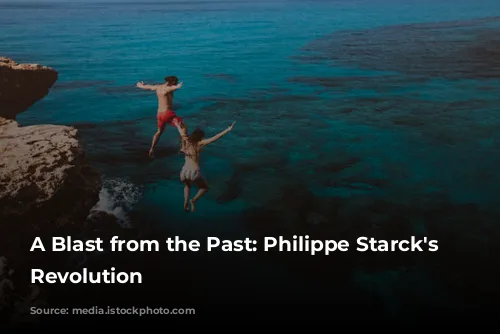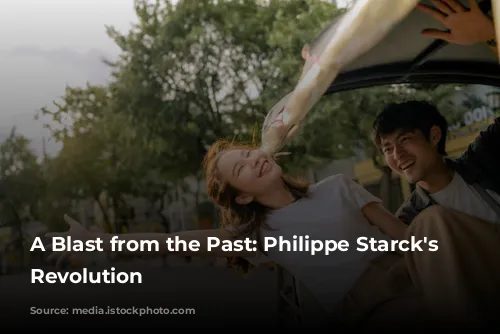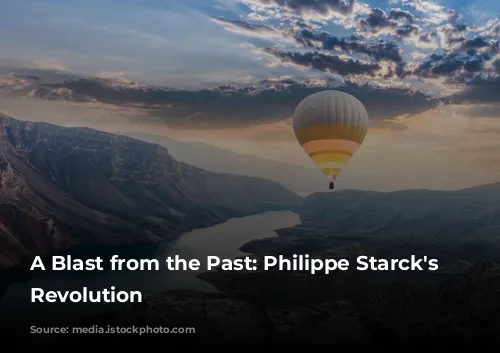The bold and unconventional creations of French designer Philippe Starck from the 1980s are making a comeback! A trio of exhibitions in Paris are shining a spotlight on his groundbreaking work, showcasing the enduring influence of his iconic designs. These exhibits reveal a surge of interest in Starck’s signature style from that era, which propelled him to international fame and made him a household name.
From iconic industrial products like the humble lemon squeezer to the instantly recognizable Louis Ghost chair for Kartell, Starck’s creations have graced countless hotels and restaurants worldwide. His furniture pieces, along with designs by other prominent figures in the French design scene like Martin Szekely and Elisabeth Garouste and Mattia Bonetti, are featured in the multi-disciplinary exhibition “Années 80. Mode, design et graphisme en France” at the Musée des Arts Décoratifs, showcasing a vibrant tapestry of fashion, design, and graphic art from the 1980s.

Starck’s 80s Revival: A Look Back at a Design Revolution
While Starck is known for his daring and humorous designs, he’s somewhat amused by the recent resurgence of interest in his 1980s creations. “Getting older is awful,” he quipped to Artnet News, acknowledging the curious phenomenon of the past catching up with the present. Despite the renewed attention, Starck remains firmly focused on the future.
“I don’t think anything of the past; I’ve always thought about the future but never about the past,” he declared, revealing his unwavering fascination with the possibilities of tomorrow. His father, an aeronautical engineer, instilled in him an enduring love for futuristic forms and materials, fueling his creative vision.

The Power of Innovation: How Starck Redefined Furniture
Despite the recent surge in interest, Starck sees the market’s focus on his 1980s work as a form of speculation. “It’s completely artificial because they think that I’m going to die, so one must increase the market value. It’s normal speculation in the field of artistic creation,” he explained. While he recognizes the market forces at play, Starck doesn’t let this overshadow the true spirit of his 1980s creations.
He fondly recalls the era as a time of boundless creativity, where he and his team overcame financial constraints and a lack of belief to produce innovative designs. “What’s interesting is that the pieces were made with nothing,” Starck mused, “We had zero money, no one believed in us, there was no investment, we produced the pieces ourselves. It really was an incredible adventure.”

A Legacy of Revolution: From Iconic Chairs to Institutional Importance
Starck’s 1980s designs were a rebellion against convention, pushing the boundaries of traditional furniture design. The exhibition showcases his greatest hits, including the Pat Conley II armchair (1983) with its gracefully sloping seat, the Dr Sonderbar armchair (1983) in stainless chrome metal with its elliptical form standing on just three legs, and the striking black, graphic chairs Miss Dorn (1982) and Wendy Wright (1986). His iconic Easylight (1979) neon sculpture evokes the spirit of Dan Flavin’s minimalist works, further demonstrating Starck’s eclectic inspirations.
Starck’s impact extends beyond the world of furniture design. His Fauteuil Club (1983) was acquired by French president François Mitterrand for the bedroom of his wife, Danielle, at the Elysée Palace. This piece epitomizes Starck’s anti-bourgeois approach, challenging traditional notions of luxury and redefining the classic armchair.

A Design Legacy for Generations: Starck’s Enduring Appeal
The exhibitions offer a captivating glimpse into the evolution of Starck’s career, from his early revolutionary work to his enduring influence on the design landscape. Prices for his 1980s pieces are still relatively affordable, attracting a new generation of collectors seeking a piece of the vibrant and unconventional 1980s.
Starck’s iconic designs continue to inspire and captivate, reminding us that timeless style often stems from breaking the rules and embracing bold, creative visions.










